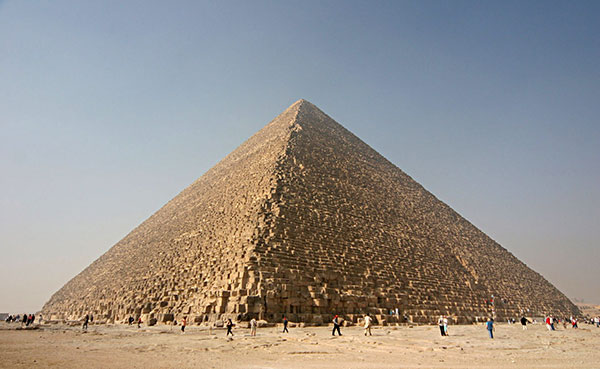When someone mentions Egypt, the first thing which naturally comes to your mind is an image of the Pyramids of Giza, just outside of the capital, Cairo. But did you know that there are actually more than 130 of these structures in the entire country? This is just one of the fascinating facts which you will learn here. Check out the rest of the list to grow your knowledge on the pyramids and on Ancient Egypt as a whole.

Source: Wikipedia
# One
The oldest known pyramid in Egypt was built for the pharaoh Djoser. Located at Saqqara, one of the largest burial grounds for kings, it is also known as the Step Pyramid for its structure, which allowed climbing, in ancient times at least. This pyramid was built around 2630 BC. This means that it is over 4600 years old!
# Two
The architect of the first pyramid Imhotep had numerous talents. He was a priest, healer and mathematician. Some 14 centuries after the time of the construction of Djoser’s pyramid, Imhotep became the patron saint of physicians in Ancient Egypt.
# Three
The earliest known Egyptian pyramid with flat (smooth, not stepped) sides is the Red Pyramid at Dahshur. It was built for the pharaoh Sneferu who ruled between 2613 and 2589 BC.

# Four
The Great Pyramid of Giza is the oldest and largest of all three. Its base spreads over 592,000 square feet (55,000 square meters). Originally, it was 481.4 feet (147 meters) high. It was built for the pharaoh Khufu who ruled the country between 2589 and 2566 BC.
# Five
In their writings, the Ancient Greeks used the name of Khufu in their language – Cheops. That is why the Great Pyramid of Giza is also known as the Pyramid of Cheops.
# Six
Next to the Great Pyramid of Giza built for Khufu lie the 3 pyramids built for his queens. Smaller mastabas (tombs with pyramidal base and flat top with step structure) were built for relatives and officials of the pharaoh to accompany him and serve him in the afterlife.
# Seven
Some 2.3 million stone blocks must have been used for the building of the Great Pyramid of Giza, according to modern calculations. The average block weighed 2.5 tons. The whole structure weighs approximately 5.75 million tons.
# Eight
The sides of the Great Pyramid of Giza are orientated exactly to point East, West, North and South respectively. They rise at an angle of 51°52′. The entrance to the pyramid is on its north side. It is 59 feet (17 meters) above the ground.
# Nine
The Great Pyramid is the oldest of the Seven Wonders of the Ancient World and the best preserved one too. It held the title “tallest manmade structure in the world” for nearly 4 millennia (3800 years) until the construction of the Lincoln Cathedral in England around 1311.
# Ten
No hieroglyphics have ever been found inside the Pyramid of Khufu. It is believed that there have never been any. This is just another one of the known facts which fuels speculations that the purpose of the pyramid was different from being the final resting place of the pharaoh.
# Eleven
The middle pyramid at Giza was built to be the tomb of Khufu’s son Khafre who ruled between 2558 and 2532 BC. The Great Sphinx was also constructed during his reign. It was actually carved out of limestone. The role of the monument, a creature with the body of a lion and the head of a men, was to guard the tomb of the king. The Great Sphinx is 240 feet long and 66 feet high.
# Twelve
The shortest of the three Pyramids of Giza was built for the son of Khafre and grandson of Khufu, Menkaure who reigned between 2532 and 2503 BC. With it height of 218 feet, it is over two times shorter compared to the Great Pyramid.
# Thirteen
Calculations reveal that the three Pyramids of Giza are aligned in the same way as the three stars of Orion’s Belt, one of the best known constellations visible in the sky during the night. It is believed that this was a deliberate act on the part of the Ancient Egyptians who associated the constellation with Osiris, the god of afterlife and rebirth in their religion.
# Fourteen
At the time of their construction, the Pyramids of Giza were covered with special casing stones. These were perfectly well polished pieces of limestone. When they were laid on the sides of the pyramids, they reflected the sun’s light and made the structures shine like diamonds, literally. They would be visible from miles away as they are on a perfectly flat plateau.
# Fifteen
The latest archeological findings reveal that the Pyramids of Giza were actually built by local workers and not by slaves. Their settlement, which has been discovered only recently, had a variety of amenities including shops.
# Sixteen
The temperature inside the Egyptian pyramids stays constant at around 20 degrees Celsius (60 degrees Fahrenheit) practically all year round regardless of the temperature fluctuations between day and night which tend to be fairly large.

Source Wikipedia
# Seventeen
The body of the deceased pharaoh was mummified and place inside a sarcophagus. Although the entrance to every pyramid was neatly sealed, practically all of them were plundered during ancient times of later on throughout history.
# Eighteen
All pyramids built in Ancient Egypt are located on the west bank of the River Nile. The sun sets to the west and this is the direction associated with the path of the kingdom of the dead.
# Nineteen
The mortar which was used by the ancient builders helped to preserve the ancient periods for millennia, despite the common misconception that the secret lies with the stone. One very interesting fact is that we still do not know the formula for the making of this mortar despite our advanced technology.
# Twenty
The end of the great pyramid building era came during the rule of the pharaoh Pepy II from 2278 to 2184 BC. He was the last pharaoh to have such a large and impressive tomb built as his final resting place. His pyramid, which is 172 feet (54 meters) high, is at Saqqara just like the one of the first known pyramid builder – Djoser.


